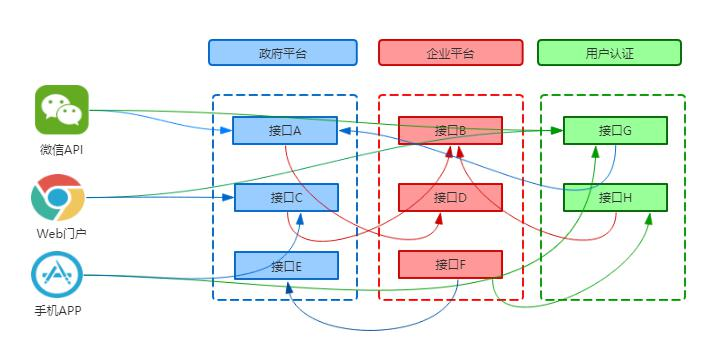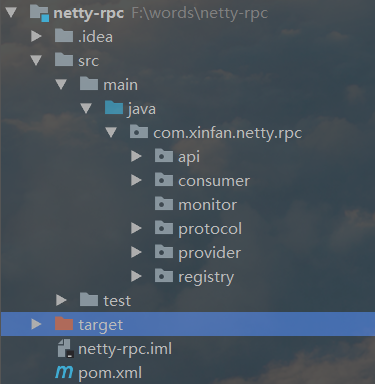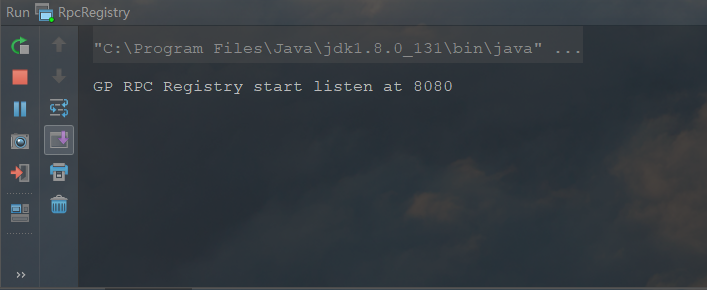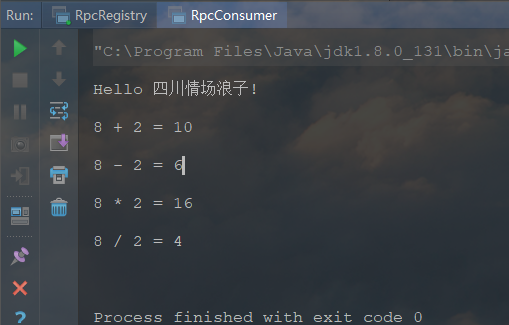01 RPC overview
The following picture, which many small partners have seen, is a picture on Dubbo's official website describing the evolution of the project architecture.
It describes the configuration and organization of each architecture. When the website traffic is very small, only one application is needed to deploy all functions together to reduce the deployment node and cost. We usually adopt a single application architecture. After that, the ORM framework appeared, which is mainly used to simplify the workflow of adding, deleting, modifying and querying. The data access framework ORM is the key.
With the increase of the number of users, when the number of visits increases gradually, and a single application increases the machine, the acceleration is smaller and smaller. We need to split the application into several applications that do not interfere with each other to improve the efficiency, so a vertical application architecture appears. MVC architecture is a very classic architecture for accelerating the development of front-end pages.
When more and more vertical applications, the interaction between applications is inevitable, the core business will be extracted, as an independent service, gradually forming a stable service center, so that the front-end applications can respond more quickly, the changing market demand, there is a distributed service architecture. In order to improve the management efficiency, RPC framework came into being. RPC is used to improve service reuse and integration, and RPC is the key under the distributed service framework.
The next generation framework will be mobile computing architecture. When more and more services, the evaluation of capacity, waste of resources of small services and other issues, gradually obvious. At this time, we need to add a dispatch center to manage the cluster capacity in real time based on the access pressure and improve the cluster utilization. SOA architecture is used to improve its utilization, resource scheduling and Governance Center SOA is the key.
Netty basically exists as the technical bottom layer of the architecture, which mainly completes high-performance network communication.
02 environment preset
Step 1: first, we set up the project environment and create the pom.xml configuration file as follows:
<dependency> <groupId>io.netty</groupId> <artifactId>netty-all</artifactId> <version>4.1.6.Final</version> </dependency> <dependency> <groupId>org.projectlombok</groupId> <artifactId>lombok</artifactId> <version>1.16.10</version> </dependency>
Step 2: create the project structure.
Before there was no RPC framework, our service calls were as follows:
It can be seen from the above figure that the call of the interface has no rules to follow. If you want to adjust it, you can adjust it. This leads to a certain stage of business development, the maintenance of the interface becomes very difficult. So some people put forward the concept of service governance. All services are not allowed to be directly called, but first register in the registration center, and then the registration center will coordinate and manage the status of all services and publish them to the public. The caller only needs to remember the service name and go to the registration center to obtain services. In this way, the management of services is greatly standardized, and the controllability of all servers can be improved. In fact, the whole design idea can also find living cases in our life. For example: we usually use IM tools for work communication, rather than face-to-face shouting. You just need to remember each other's numbers (such as Tencent QQ) provided by operators (that is, registration center). Another example: when we call, all phone numbers are assigned by the operator. When we need to talk to someone, we only need to dial the number of the other party, and the operator (Registration Center, such as China Mobile, China Unicom, China Telecom) will help us transfer the signal.
At present, the popular RPC service governance frameworks mainly include Dubbo and Spring Cloud. Let me take the classic Dubbo as an example. There are four core modules of Dubbo: Registry registration center, Provider server, Consumer and Monitor monitoring center, as shown below:
Registry
Consumer
Server (Provider)
Monitoring center
For convenience, we put all modules into one project. The main modules include:
api: mainly used to define the open function and service interface.
Protocol: mainly defines the content of custom transport protocol.
registry: mainly responsible for saving all available service names and service addresses.
provider: to realize the specific functions of all services provided externally.
consumer: client call.
monitor: complete call chain monitoring.
Next, let's build the project structure. The specific screenshot of the project structure is as follows:
03 code practice
3.1 create API module
First, create the API module. Both provider and consumer follow the specification of the API module. To simplify, create two Service interfaces, which are:
package com.xinfan.netty.rpc.api; /** * IRpcHelloService * * @author Lss * @date 2020/2/18 22:50 * @Version 1.0 */ public interface IRpcHelloService { String hello(String name); }
Create the IRpcService interface, and complete the addition, subtraction, multiplication, and division operations of analog services. The specific code is as follows:
package com.xinfan.netty.rpc.api; /** * IRpcService * * @author Lss * @date 2020/2/18 22:51 * @Version 1.0 */ public interface IRpcService { /** plus */ public int add(int a,int b); /** reduce */ public int sub(int a,int b); /** ride */ public int mult(int a,int b); /** except */ public int div(int a,int b); }
At this point, the API module definition is complete, very simple. Next, we need to determine the transmission rules, that is, the transmission protocol. Of course, the content of the protocol must be customized to reflect the advantages of Netty.
3.2 create a custom agreement
The built-in HTTP protocol in Netty requires HTTP codec and decoder to complete the parsing. Let's see how to set the custom protocol?
To complete a custom protocol in Netty, it's very simple. You only need to define a common Java class. At present, handwritten RPC is mainly used for remote calling of Java code (similar to RMI, you should be familiar with it). What content of remote calling java code must be transmitted by the network? For example, service name? Which method of the service needs to be called? What are the arguments to the method? All these information needs to be transmitted to the server through the client.
Let's look at the specific code implementation and define the InvokerProtocol class:
import lombok.Data; import java.io.Serializable; /** * InvokerProtocol * * @author Lss * @date 2020/2/18 22:54 * @Version 1.0 */ @Data public class InvokerProtocol implements Serializable { //Class name private String className; //Function name (method name) private String methodName; //Parameter type private Class<?>[] parames; //parameter list private Object[] values; }
From the above code, we can see that the main information contained in the protocol includes class name, function name, parameter list and argument list, through which we can locate a specific business logic implementation.
3.3 implement the service logic of Provider server
We implement all the functions defined in the API in the provider module, and create two implementation classes respectively:
Rphelloserviceimpl class:
package com.xinfan.netty.rpc.provider; import com.xinfan.netty.rpc.api.IRpcHelloService; /** * RpcHelloServiceImpl * * @author Lss * @date 2020/2/18 23:00 * @Version 1.0 */ public class RpcHelloServiceImpl implements IRpcHelloService{ @Override public String hello(String name) { return "Hello " + name + "!"; } }
RpcServiceImpl class:
package com.xinfan.netty.rpc.provider; import com.xinfan.netty.rpc.api.IRpcService; /** * RpcServiceImpl * * @author Lss * @date 2020/2/18 23:00 * @Version 1.0 */ public class RpcServiceImpl implements IRpcService { @Override public int add(int a, int b) { return a + b; } @Override public int sub(int a, int b) { return a - b; } @Override public int mult(int a, int b) { return a * b; } @Override public int div(int a, int b) { return a / b; } }
3.4 complete registration of Registry service
The main function of registry is to register the service names and service reference addresses of all providers into a container and publish them to the public. Registry should start an external service. Obviously, it should serve as the server and provide an external accessible port. First, start a Netty service and create the RpcRegistry class. The specific code is as follows:
package com.xinfan.netty.rpc.registry; import io.netty.bootstrap.ServerBootstrap; import io.netty.channel.*; import io.netty.channel.nio.NioEventLoopGroup; import io.netty.channel.socket.SocketChannel; import io.netty.channel.socket.nio.NioServerSocketChannel; import io.netty.handler.codec.LengthFieldBasedFrameDecoder; import io.netty.handler.codec.LengthFieldPrepender; import io.netty.handler.codec.serialization.ClassResolvers; import io.netty.handler.codec.serialization.ObjectDecoder; import io.netty.handler.codec.serialization.ObjectEncoder; /** * RpcRegistry * * @author Lss * @date 2020/2/18 23:27 * @Version 1.0 */ public class RpcRegistry { private int port; public RpcRegistry(int port){ this.port = port; } public void start(){ EventLoopGroup bossGroup = new NioEventLoopGroup(); EventLoopGroup workerGroup = new NioEventLoopGroup(); try { ServerBootstrap b = new ServerBootstrap(); b.group(bossGroup, workerGroup) .channel(NioServerSocketChannel.class) .childHandler(new ChannelInitializer<SocketChannel>() { @Override protected void initChannel(SocketChannel ch) throws Exception { ChannelPipeline pipeline = ch.pipeline(); //Custom protocol decoder /** There are 5 input parameters, which are explained as follows maxFrameLength: The maximum length of the frame. If the length of the frame is greater than this value, a TooLongFrameException is thrown. lengthFieldOffset: Offset of length field: the position of the corresponding length field in the whole message data lengthFieldLength: The length of the length field. For example, if the length field is int type, then the value is 4 (long type is 8) lengthAdjustment: Compensation value to add to length field value initialBytesToStrip: Number of first bytes removed from decoded frame */ pipeline.addLast(new LengthFieldBasedFrameDecoder(Integer.MAX_VALUE, 0, 4, 0, 4)); //Custom protocol encoder pipeline.addLast(new LengthFieldPrepender(4)); //Object parameter type encoder pipeline.addLast("encoder",new ObjectEncoder()); //Object parameter type decoder pipeline.addLast("decoder",new ObjectDecoder(Integer.MAX_VALUE,ClassResolvers.cacheDisabled(null))); pipeline.addLast(new RegistryHandler()); } }) .option(ChannelOption.SO_BACKLOG, 128) .childOption(ChannelOption.SO_KEEPALIVE, true); ChannelFuture future = b.bind(port).sync(); System.out.println("GP RPC Registry start listen at " + port ); future.channel().closeFuture().sync(); } catch (Exception e) { bossGroup.shutdownGracefully(); workerGroup.shutdownGracefully(); } } public static void main(String[] args) throws Exception { new RpcRegistry(8080).start(); } }
The specific logic of registration is implemented in the RegistryHandler. The above code mainly realizes the function of service registration and service invocation. Because all modules are created in the same project, in order to simplify, the server does not use remote call, but directly scans the local Class, and then uses reflection call. The code implementation is as follows:
package com.xinfan.netty.rpc.registry; import com.xinfan.netty.rpc.protocol.InvokerProtocol; import io.netty.channel.ChannelHandlerContext; import io.netty.channel.ChannelInboundHandlerAdapter; import java.io.File; import java.io.FileInputStream; import java.io.UnsupportedEncodingException; import java.lang.reflect.Method; import java.net.URI; import java.net.URL; import java.util.ArrayList; import java.util.List; import java.util.concurrent.ConcurrentHashMap; /** * RegistryHandler * * @author Lss * @date 2020/2/18 23:58 * @Version 1.0 */ public class RegistryHandler extends ChannelInboundHandlerAdapter { //Save all available services with public static ConcurrentHashMap<String, Object> registryMap = new ConcurrentHashMap<String,Object>(); //Save all related service classes private List<String> classNames = new ArrayList<String>(); public RegistryHandler(){ //Complete recursive scan scannerClass("com.xinfan.netty.rpc.provider"); doRegister(); } @Override public void channelRead(ChannelHandlerContext ctx, Object msg) throws Exception { Object result = new Object(); InvokerProtocol request = (InvokerProtocol)msg; //When the client establishes a connection, it needs to obtain information from the custom protocol and get specific services and parameters //Using reflection calls if(registryMap.containsKey(request.getClassName())){ Object clazz = registryMap.get(request.getClassName()); Method method = clazz.getClass().getMethod(request.getMethodName(), request.getParames()); result = method.invoke(clazz, request.getValues()); } ctx.write(result); ctx.flush(); ctx.close(); } @Override public void exceptionCaught(ChannelHandlerContext ctx, Throwable cause) throws Exception { cause.printStackTrace(); ctx.close(); } /* * Recursive scanning */ private void scannerClass(String packageName){ URL url = this.getClass().getClassLoader().getResource(packageName.replaceAll("\\.", "/")); File dir = new File(url.getFile()); for (File file : dir.listFiles()) { //If it is a folder, continue recursion if(file.isDirectory()){ scannerClass(packageName + "." + file.getName()); }else{ classNames.add(packageName + "." + file.getName().replace(".class", "").trim()); } } } /** * Completion of registration */ private void doRegister(){ if(classNames.size() == 0){ return; } for (String className : classNames) { try { Class<?> clazz = Class.forName(className); Class<?> i = clazz.getInterfaces()[0]; registryMap.put(i.getName(), clazz.newInstance()); } catch (Exception e) { e.printStackTrace(); } } } }
At this point, the basic functions of the registry have been completed. Let's see the code implementation of the client.
3.5 implementation of Consumer remote call
Sort out the basic implementation ideas, mainly to complete a function like this: the interface function in the API module is implemented in the server (not in the client). Therefore, when a client calls an interface method defined in the API, it actually needs to initiate a network request to call a service on the server. The network request is first received by the registration center. The registration center first determines the location of the service to be called, then forwards the request to the real service implementation, finally calls the server code, and transmits the return value to the client through the network. The whole process is completely insensitive to the client, just like calling a local method. The specific calling process is shown in the following figure:
Let's look at the code implementation and create the RpcProxy class:
package com.xinfan.netty.rpc.consumer.proxy; import com.xinfan.netty.rpc.protocol.InvokerProtocol; import io.netty.bootstrap.Bootstrap; import io.netty.channel.*; import io.netty.channel.nio.NioEventLoopGroup; import io.netty.channel.socket.SocketChannel; import io.netty.channel.socket.nio.NioSocketChannel; import io.netty.handler.codec.LengthFieldBasedFrameDecoder; import io.netty.handler.codec.LengthFieldPrepender; import io.netty.handler.codec.serialization.ClassResolvers; import io.netty.handler.codec.serialization.ObjectDecoder; import io.netty.handler.codec.serialization.ObjectEncoder; import java.lang.reflect.InvocationHandler; import java.lang.reflect.Method; import java.lang.reflect.Proxy; /** * RpcProxy * * @author Lss * @date 2020/2/19 12:10 * @Version 1.0 */ public class RpcProxy { public static <T> T create(Class<?> clazz){ //clazz came in as an interface MethodProxy proxy = new MethodProxy(clazz); Class<?> [] interfaces = clazz.isInterface() ? new Class[]{clazz} : clazz.getInterfaces(); T result = (T) Proxy.newProxyInstance(clazz.getClassLoader(),interfaces,proxy); return result; } private static class MethodProxy implements InvocationHandler { private Class<?> clazz; public MethodProxy(Class<?> clazz){ this.clazz = clazz; } @Override public Object invoke(Object proxy, Method method, Object[] args) throws Throwable { //If the passed in is an implemented concrete class (this demonstration skips this logic) if (Object.class.equals(method.getDeclaringClass())) { try { return method.invoke(this, args); } catch (Throwable t) { t.printStackTrace(); } //If you pass in an interface (core) } else { return rpcInvoke(proxy,method, args); } return null; } /** * The core method of implementing interface * @param method * @param args * @return */ public Object rpcInvoke(Object proxy,Method method,Object[] args){ //Transport protocol encapsulation InvokerProtocol msg = new InvokerProtocol(); msg.setClassName(this.clazz.getName()); msg.setMethodName(method.getName()); msg.setValues(args); msg.setParames(method.getParameterTypes()); final RpcProxyHandler consumerHandler = new RpcProxyHandler(); EventLoopGroup group = new NioEventLoopGroup(); try { Bootstrap b = new Bootstrap(); b.group(group) .channel(NioSocketChannel.class) .option(ChannelOption.TCP_NODELAY, true) .handler(new ChannelInitializer<SocketChannel>() { @Override public void initChannel(SocketChannel ch) throws Exception { ChannelPipeline pipeline = ch.pipeline(); //Custom protocol decoder (the code of the server can be copied) /** There are 5 input parameters, which are explained as follows maxFrameLength: The maximum length of the frame. If the length of the frame is greater than this value, a TooLongFrameException is thrown. lengthFieldOffset: Offset of length field: the position of the corresponding length field in the whole message data lengthFieldLength: Length field length: for example, if the length field is int type, then the value is 4 (long type is 8) lengthAdjustment: Compensation value to add to length field value initialBytesToStrip: Number of first bytes removed from decoded frame */ pipeline.addLast("frameDecoder", new LengthFieldBasedFrameDecoder(Integer.MAX_VALUE, 0, 4, 0, 4)); //Custom protocol encoder pipeline.addLast("frameEncoder", new LengthFieldPrepender(4)); //Object parameter type encoder pipeline.addLast("encoder", new ObjectEncoder()); //Object parameter type decoder pipeline.addLast("decoder", new ObjectDecoder(Integer.MAX_VALUE, ClassResolvers.cacheDisabled(null))); pipeline.addLast("handler",consumerHandler); } }); ChannelFuture future = b.connect("localhost", 8080).sync(); future.channel().writeAndFlush(msg).sync(); future.channel().closeFuture().sync(); } catch(Exception e){ e.printStackTrace(); }finally { group.shutdownGracefully(); } return consumerHandler.getResponse(); } } }
Receive the return value of the network call RpcProxyHandler class:
package com.xinfan.netty.rpc.consumer.proxy; import io.netty.channel.ChannelHandlerContext; import io.netty.channel.ChannelInboundHandlerAdapter; /** * RpcProxyHandler * * @author Lss * @date 2020/2/19 12:36 * @Version 1.0 */ public class RpcProxyHandler extends ChannelInboundHandlerAdapter{ private Object response; public Object getResponse() { return response; } @Override public void channelRead(ChannelHandlerContext ctx, Object msg) throws Exception { response=msg; } @Override public void exceptionCaught(ChannelHandlerContext ctx, Throwable cause) throws Exception { System.out.println("client exception is general"); } }
Complete the client call code RpcConsumer class:
package com.xinfan.netty.rpc.consumer; import com.xinfan.netty.rpc.api.IRpcHelloService; import com.xinfan.netty.rpc.api.IRpcService; import com.xinfan.netty.rpc.consumer.proxy.RpcProxy; /** * RpcConsumer * * @author Lss * @date 2020/2/19 12:55 * @Version 1.0 */ public class RpcConsumer { public static void main(String[] args) { IRpcHelloService rpcHello= RpcProxy.create(IRpcHelloService.class); System.out.println(rpcHello.hello("Sichuan lover")); IRpcService service=RpcProxy.create(IRpcService.class); System.out.println("8 + 2 = " + service.add(8, 2)); System.out.println("8 - 2 = " + service.sub(8, 2)); System.out.println("8 * 2 = " + service.mult(8, 2)); System.out.println("8 / 2 = " + service.div(8, 2)); //Monitor in Dubbo is implemented with Spring's AOP embedded point. I did not introduce the Spring framework } }
3.6 Monitor monitoring
The Monitor in Dubbo is implemented with Spring's AOP embedded point. I didn't introduce the Spring framework. I don't implement the monitoring function in this code. Interested partners can review the previous Spring AOP courses to improve this function.
04 operation effect demonstration
The first step is to start the registration center. The operation results are as follows:
Step 2: run the client, and the result is as follows:
Through the above case demonstration, I believe that my friends have been quite impressed by the application of Netty. This time, I just made a simple implementation of the basic implementation principle of RPC. Interested partners can continue to improve other details of RPC on the basis of this project. Welcome message

